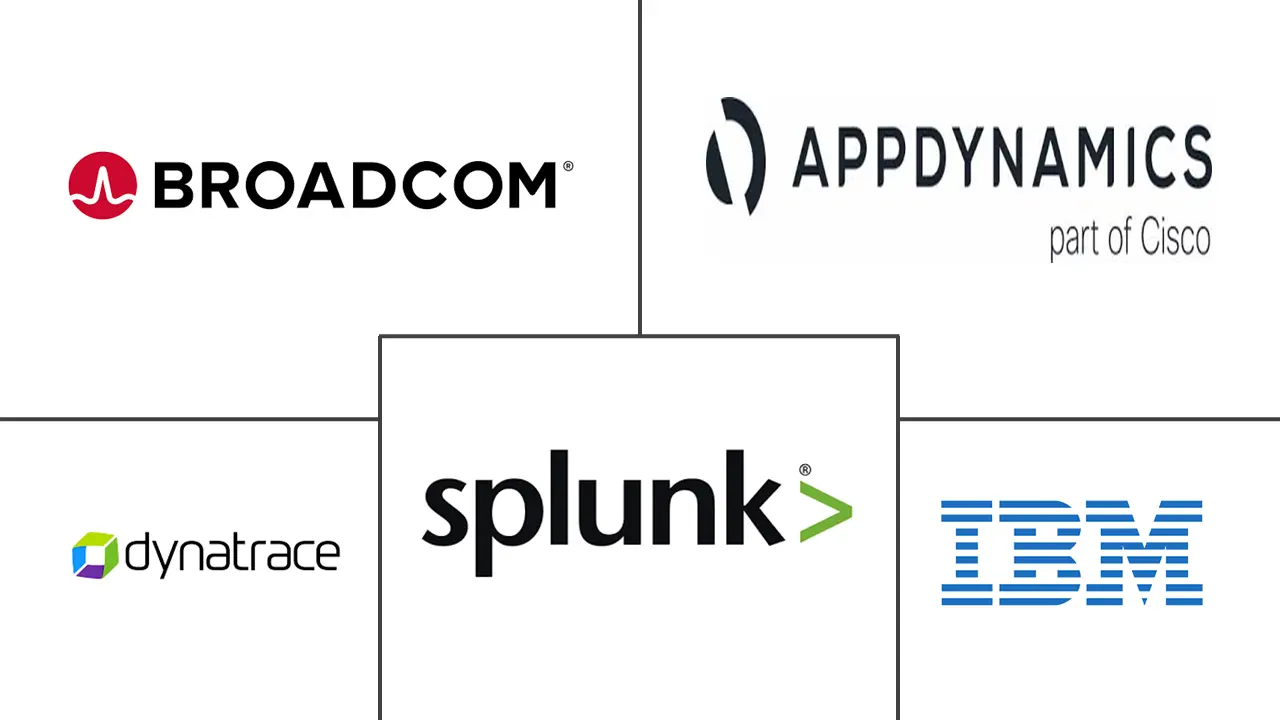AIOps Market Size and Share
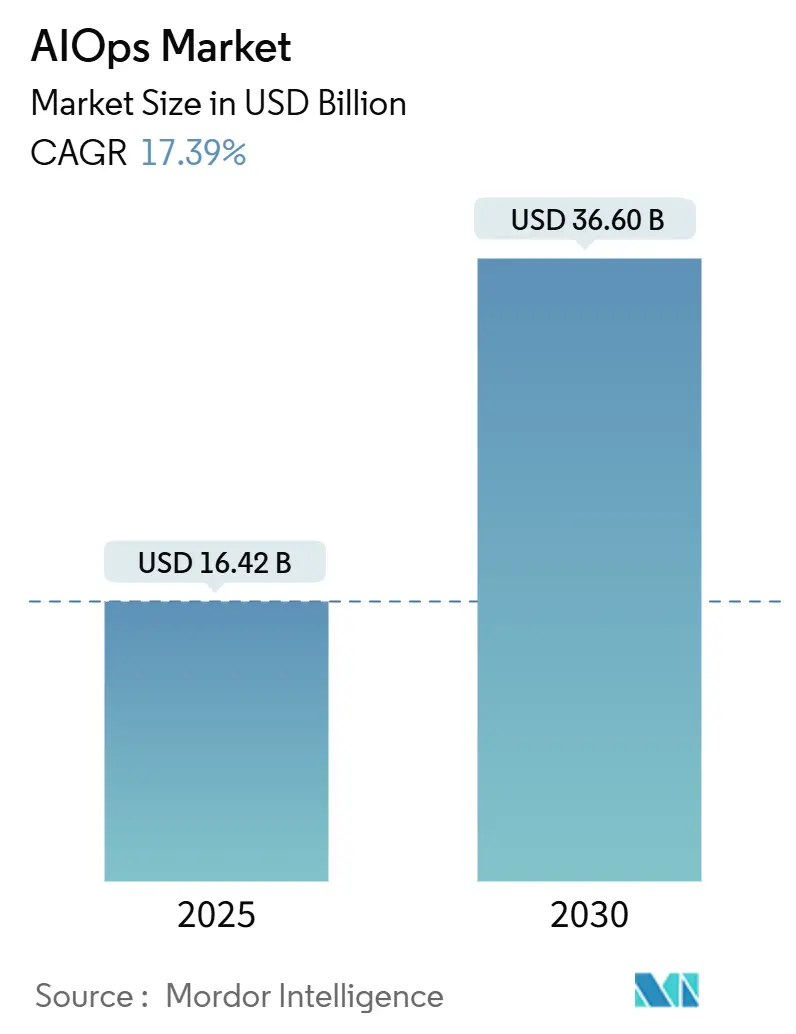
AIOps Market Analysis by Mordor Intelligence
The AIOps market stood at USD 16.42 billion in 2025 and is forecast to reach USD 36.60 billion by 2030, advancing at a 17.39% CAGR. Demand rises as enterprises struggle with complex hybrid clouds, escalating observability data, and the pressure to cut operating costs while raising service resilience. Vendors now embed large language models into traditional monitoring, enabling autonomous incident response that reduces noise, accelerates root-cause discovery, and optimizes capacity planning. Platform consolidation is gathering pace as buyers tire of fragmented tool sets that inflate license spend and slow decision-making. Consumption-based pricing and open standards such as OpenTelemetry also lower entry barriers, pulling small and medium enterprises into the purchasing cycle.
Key Report Takeaways
- By component, platform solutions held 82.4% of revenue in 2024 and expected to register a CAGR of 17.5%, while services grow as enterprises seek implementation expertise.
- By deployment mode, on-premise remained the largest share at 56.2% in 2024; cloud is expanding at an 18.7% CAGR to 2030.
- By organization size, large enterprises drove 72.2% of 2024 demand; the SME segment is the fastest riser with an 18.9% CAGR.
- By end-user, the BFSI sector commanded 26.5% of the AIOps market share in 2024, whereas healthcare is poised for a 17.8% CAGR to 2030.
- By geography, North America led with 38.2% revenue in 2024; Asia-Pacific is projected to grow at 19.2% CAGR through 2030.
Global AIOps Market Trends and Insights
Drivers Impact Analysis
| Driver | (~) % Impact on CAGR Forecast | Geographic Relevance | Impact Timeline |
|---|---|---|---|
| AI-driven observability demand surge | +3.2% | Global, with concentration in North America and Asia-Pacific | Medium term (2-4 years) |
| Shift to hybrid / multi-cloud architectures | +2.8% | Global, particularly North America and Europe | Short term (≤ 2 years) |
| Need for faster MTTR and SRE adoption | +2.1% | Global, led by technology-forward regions | Short term (≤ 2 years) |
| Gen-AI copilots for ops | +1.9% | North America and Europe early adoption, Asia-Pacific following | Medium term (2-4 years) |
| FPGA/DPUs enabling real-time inference at edge | +1.4% | Asia-Pacific core, spill-over to North America | Long term (≥ 4 years) |
| ESG-linked "green ops" compliance | +0.8% | Europe leading, North America and Asia-Pacific following | Long term (≥ 4 years) |
| Source: Mordor Intelligence | |||
AI-Driven Observability Demand Surge
Telemetry volume now runs into petabytes per day, overwhelming traditional monitoring. Modern AIOps platforms correlate logs, metrics, and traces to cut alert noise by up to 75%, while mission-critical sectors such as financial services record 99% mainframe task automation after consolidation onto a single platform. The capability becomes pivotal as cloud-native applications generate 10 times more data than monoliths, making manual triage impractical. Vendors embed machine learning that detects anomalous patterns across data silos, preventing user-visible failures and sustaining uptime requirements.
Shift to Hybrid/Multi-Cloud Architectures
About 82% of enterprises run hybrid strategies and 92% use multiple public clouds, creating fragmented visibility and diverse API surfaces.[1]Cisco Executive Perspectives, “Annual Hybrid Cloud Report,” cisco.comForty-five percent already deploy AIOps to unify monitoring, and early adopters report 38% faster incident resolution once cross-domain correlation is automated. Economic urgency mounts as cloud expenditure climbs, making algorithmic resource optimization a board-level priority.
Need for Faster MTTR and SRE Adoption
Site reliability engineering practices hinge on proactive detection and automated remediation. AIOps tools narrow mean time to resolution: 65% of manufacturing organizations record MTTR gains after rolling out observability platforms.[2]New Relic Research, “2025 State of Observability,” newrelic.com By automating root-cause analytics and remediation runbooks, the technology reduces expertise barriers that have slowed SRE rollouts in mid-sized firms.
Gen-AI Copilots for Ops
Large language models now interpret natural-language incidents, draft step-by-step runbooks, and produce stakeholder updates in real time. Microsoft Security Copilot has cut MTTR for security incidents by 30.13% only three months after go-live.[3]Jeff Teper, “Security Copilot Now Generally Available,” microsoft.com When coupled with core AIOps correlation engines, these copilots let a small team manage much larger estates thanks to conversational interfaces and autonomous remediation triggers.
Restraints Impact Analysis
| Restraint | (~) % Impact on CAGR Forecast | Geographic Relevance | Impact Timeline |
|---|---|---|---|
| Tool sprawl and ROI uncertainty | -2.1% | Global, particularly acute in North America | Short term (≤ 2 years) |
| Shortage of AIOps-savvy talent | -1.8% | Global, most severe in Asia-Pacific emerging markets | Medium term (2-4 years) |
| Data-sovereignty / AI-governance hurdles | -1.3% | Europe leading regulatory pressure, global impact | Long term (≥ 4 years) |
| Vendor black-box algorithms and lock-in risk | -0.9% | Global, with enterprise focus in North America and Europe | Medium term (2-4 years) |
| Source: Mordor Intelligence | |||
Tool Sprawl and ROI Uncertainty
Many organizations still juggle five or more monitoring tools, fragmenting context and delaying action. Integration costs rise before AIOps delivers its promised value, creating executive hesitation. The pressure is most visible in North America, where budgets tighten and procurement teams demand clear business-case evidence before greenlighting new platforms.
Shortage of AIOps-Savvy Talent
The intersection of AI and IT operations demands a hybrid skill set that remains scarce. Australian public agencies highlight the gap, with 76% unable to recruit qualified professionals, prolonging deployment cycles and inflating salaries. Without talent, enterprises struggle to tune models, interpret insights, and design governance guardrails, slowing market penetration despite clear benefits.
Segment Analysis
By Component: Platform Dominance Drives Integration
Platform offerings captured 82.4% of 2024 revenue, reinforcing the view that unified telemetry ingestion and analytics trump point solutions. Services made up the remaining 17.6% as buyers sought configuration, model training, and change-management assistance. Enterprises confirm that a single console cuts swivel-chair fatigue and accelerates decision loops. Vendors now embed pretrained models that evolve through federated learning, raising detection accuracy over time. Services growth tracks the complexity of hybrid estates, where consultants map legacy systems into modern pipelines and enforce best-practice governance.
The platform-centric shift addresses lessons from earlier tool sprawl. Proprietary engines inside leading suites deliver granular anomaly scoring that is difficult to replicate via custom integration. Partner ecosystems deepen as specialists build turnkey dashboards and agentic add-ons. RapDev’s Datadog-native AI agents illustrate the monetization potential in value-added layers, while IBM channels showcase Instana to capture adjacent service revenue.
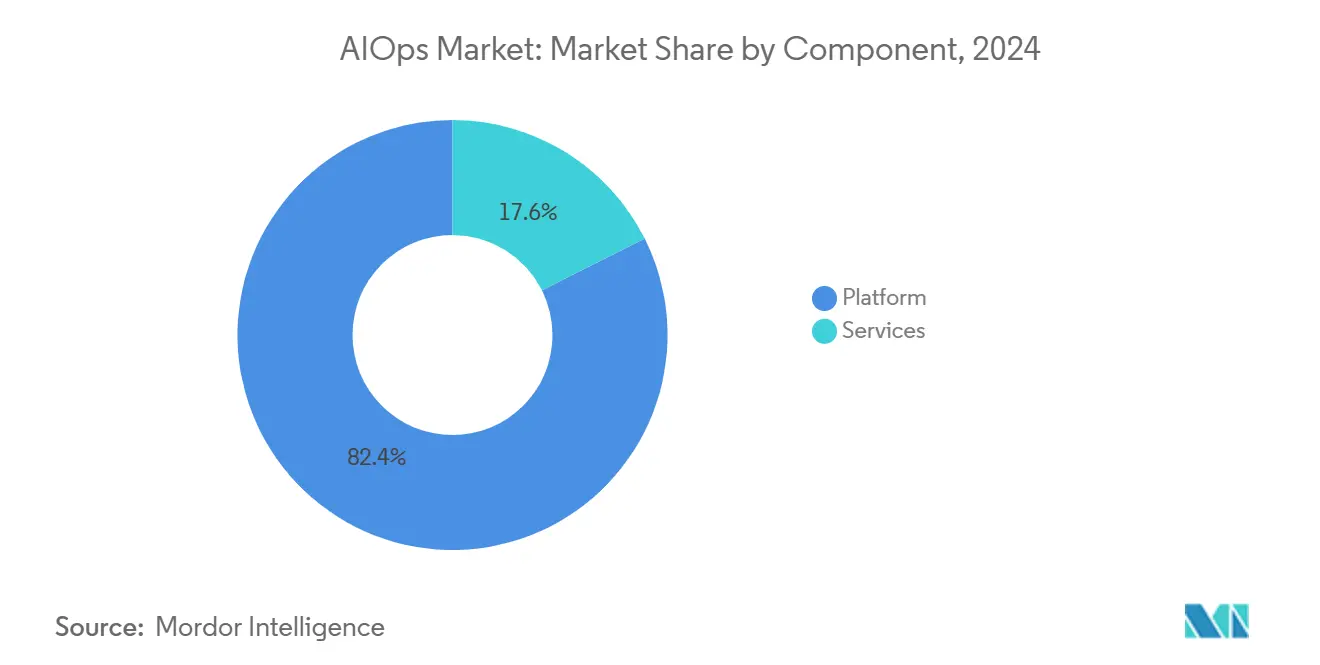
Note: Segment shares of all individual segments available upon report purchase
By Deployment Mode: Cloud Acceleration Reshapes Operations
On-premise deployments retained 56.2% share in 2024, upheld by strict data-residency rules in finance and government. The cloud segment, however, is scaling at an 18.7% CAGR to 2030 as buyers pivot to usage-based contracts that offload infrastructure management. Cloud vendors refresh AI models continuously, meaning subscribers gain incremental accuracy without forklift upgrades. Hybrid configurations now dominate proof-of-concept discussions, letting sensitive datasets stay on site while cloud analytics engines run correlation and inference at scale.
Cloud momentum signals a broader shift toward elasticity. When incidents spike, the platform can burst compute, completing multidimensional causal analysis in seconds. Encryption and zero-trust controls assuage prior security objections, encouraging even regulated entities to pilot managed observability. Cost governance features alert operations teams when ingestion volumes threaten budget thresholds, reducing surprise invoices.
By Organization Size: SME Adoption Accelerates Through Accessibility
Large enterprises generated 72.2% of demand in 2024 and continue to push feature roadmaps toward deeper automation, self-healing, and audit trails. Yet the SME cohort is expanding at an 18.9% CAGR as vendors package best practices into guided onboarding flows. Low-code connectors and prebuilt dashboards mean small IT teams can deploy within days, sidestepping bespoke integration projects.
The shift democratizes advanced operations. SMEs leverage insights to improve customer experience and cut downtime without scaling headcount, leveling the playing field against bigger rivals. Flexible monthly billing aligns with tight budgets, while marketplace integrations connect AIOps engines to CRM, ticketing, and DevOps pipelines.
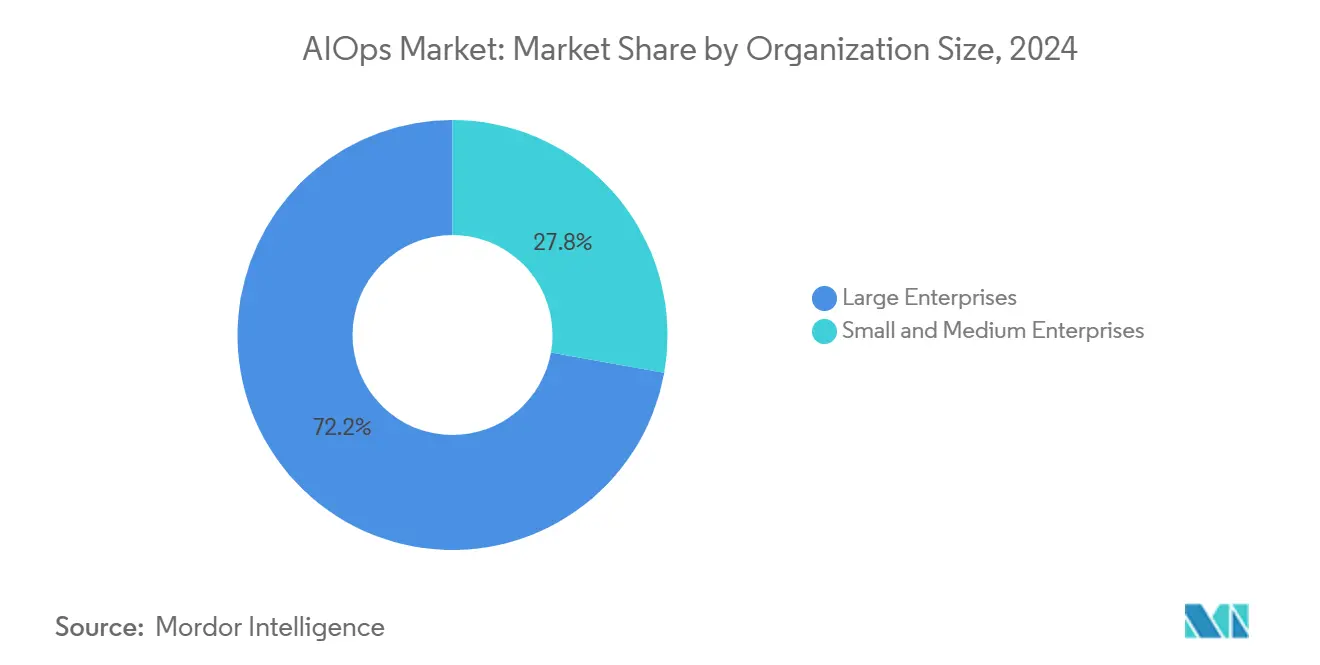
Note: Segment shares of all individual segments available upon report purchase
By End-User Industry: BFSI Leadership Meets Healthcare Innovation
The BFSI sector accounted for 26.5% of the AIOps market share in 2024 as regulators mandate demonstrable operational resilience and fraud detection. Algorithmic correlation uncovers suspicious patterns across payment rails and legacy mainframes, triggering real-time containment workflows. IT budgets in capital-markets trading desks further sustain spend due to downtime cost sensitivity.
Healthcare shows the fastest ascent with a 17.8% CAGR to 2030. Telemetry from electronic health records, connected devices, and telemedicine platforms must be monitored continuously to protect patient safety. AIOps engines flag latency, throughput, and anomaly patterns that suggest early system degradation, letting clinicians maintain service continuity. Strict data-protection laws encourage on-prem or sovereign-cloud variants, balancing privacy with analytics depth.
Geography Analysis
North America led the AIOps market with 38.2% revenue in 2024. Early adopter enterprises, a robust vendor ecosystem, and sizable cloud budgets give the region scale advantages. Federal agencies log more than 1,200 AI use cases, 228 of which run in production, proving operational maturity in mission-critical settings. Mergers and acquisitions remain active, typified by ServiceNow’s purchase of Logik.ai to enhance real-time workflow automation.
Asia-Pacific is the fastest-growing geography, forecasting a 19.2% CAGR. Governments in China, India, and Southeast Asian nations sponsor AI accelerators and subsidize cloud infrastructure, pushing enterprises to modernize operations. Observability investments deliver a median annual value of USD 10.08 million, exceeding other regions and highlighting the scale of digital transformation. Telecom operators integrate AIOps into 5G core networks to reduce outage penalties, while financial super-apps deploy anomaly detection to curb fraud at scale.
Europe maintains steady expansion propelled by ESG mandates, stringent data-sovereignty rules, and a preference for open standards. The region insists on algorithmic explainability, pressuring vendors to expose model logic and offer on-prem training options. Enterprises align AIOps rollouts with green-ops targets, measuring power consumption per telemetry gigabyte. Partnerships such as NTT DATA and HPE Aruba deliver sustainability-tuned observability suites that auto-scale resources in line with demand. Regulatory rigor slows initial procurement but ultimately cements vendor credibility when compliance certification is achieved.

Competitive Landscape
The vendor field remains moderately fragmented as legacy monitoring specialists, cloud hyperscalers, and venture-backed disruptors battle for wallet share. Platform breadth, AI model sophistication, and ecosystem add-ons outweigh price as key differentiators. Datadog, Dynatrace, IBM, ServiceNow, New Relic, Cisco-Splunk, and Microsoft embed advanced correlation and generative copilots to defend installed bases. Dynatrace’s annual recurring revenue climbed to USD 1.5 billion in 2025 on the strength of its Grail data lakehouse and Davis AI engine.
Acquisitions accelerate roadmap completeness and cross-sell potential. Cisco’s 2024 integration of Splunk brought real-time security analytics to its network portfolio, creating a full-stack observability and threat-hunting platform. Start-ups focus on niche gaps: Vespper automates alert triage using LLM agents, while Observe builds time-series indexes optimized for cloud-native logs. Service partners such as RapDev monetize specialization, winning Datadog’s Partner of the Year award through tailored AI agents that automate workflow remediation.
Price competition is softening as customers prioritize downtime avoidance over license savings. Proof-of-value pilots hinge on measurable KPI improvement in weeks rather than months. Vendors expose ROI dashboards that quantify avoided incidents, reclaimed engineer hours, and capacity savings, shifting buyer conversations from feature checklists to outcome metrics.
AIOps Industry Leaders
-
IBM
-
Cisco (AppDynamics)
-
Splunk
-
Dynatrace
-
Broadcom (incl. VMware Tanzu)
- *Disclaimer: Major Players sorted in no particular order
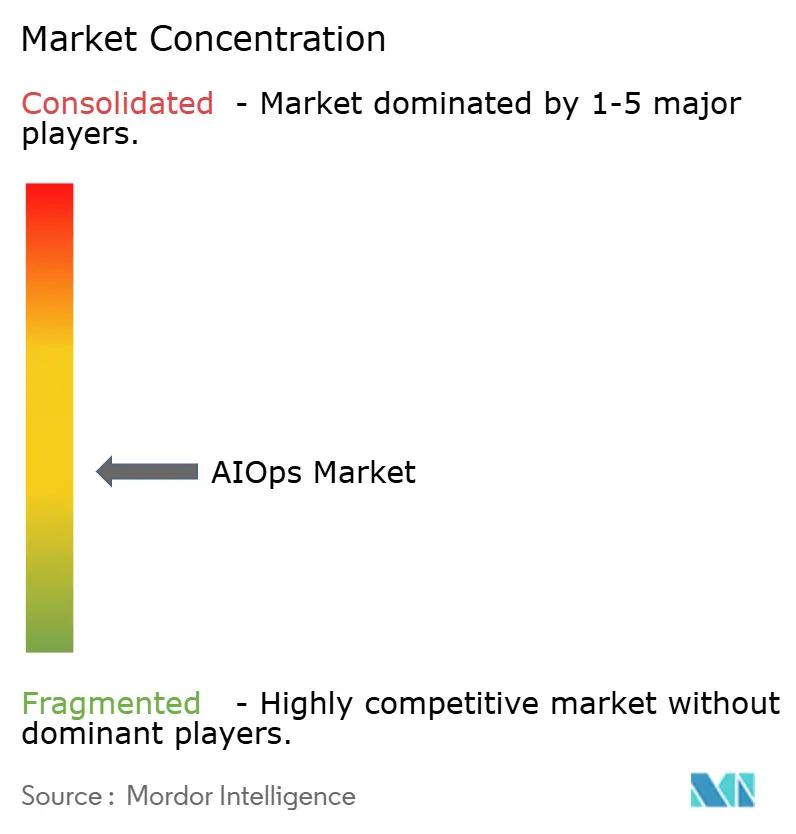
Recent Industry Developments
- April 2025: New Relic enhanced its Partner Program and added agentic AI capabilities, integrating Amazon Q Business, GitHub Copilot, Google Gemini, and ServiceNow to streamline IT operations.
- March 2025: Jio Platforms, AMD, Cisco, and Nokia launched an Open Telecom AI Platform at MWC 2025 to enable self-optimizing networks.
- March 2025: LTIMindtree reported USD 4.5 billion revenue for FY25 and positioned itself as an AI-first organization.
- February 2025: OpenText committed fresh investment in Asia-Pacific data centers to support AI-driven observability and security services.
- January 2025: Microsoft confirmed Security Copilot’s production rollout, with live data showing a 30.13% MTTR decline in security operations centers.
Research Methodology Framework and Report Scope
Market Definitions and Key Coverage
Mordor Intelligence defines the AIOps market as all platform and service revenues that apply machine learning and advanced analytics to ingest, correlate, and orchestrate IT operations data across logs, metrics, traces, events, and topology in order to predict, diagnose, and resolve incidents. The study covers commercial, subscription, and consumption-based offerings deployed on-premise or in public, private, and hybrid clouds and sold to enterprises of every size.
Scope exclusion: stand-alone observability tools that lack automated root-cause analysis or response workflows sit outside this valuation.
Segmentation Overview
- By Component
- Platform
- Services
- By Deployment Mode
- On-premise
- Cloud
- By Organization Size
- Small and Medium Enterprises
- Large Enterprises
- By End-User Industry
- IT and Telecom
- BFSI
- Healthcare
- Retail and E-commerce
- Media and Entertainment
- Manufacturing
- Government and Public Sector
- Others
- By Geography
- North America
- United States
- Canada
- Mexico
- South America
- Brazil
- Argentina
- Rest of South America
- Europe
- Germany
- United Kingdom
- France
- Rest of Europe
- Asia-Pacific
- China
- India
- Japan
- South Korea
- Rest of Asia-Pacific
- Middle East and Africa
- Middle East
- Saudi Arabia
- United Arab Emirates
- Rest of Middle East
- Africa
- South Africa
- Nigeria
- Rest of Africa
- Middle East
- North America
Detailed Research Methodology and Data Validation
Primary Research
Interviews and structured surveys with site-reliability leaders, cloud-ops architects, and channel partners across North America, Europe, and Asia-Pacific provided current price bands, average alert volumes, and emerging use-case weightings. These discussions filled data gaps and let us challenge secondary findings before locking the final numbers.
Desk Research
Our analysts began with core public datasets such as U.S. Bureau of Labor Statistics ICT spending tables, Eurostat cloud-computing penetration surveys, and OECD telecom ICT price indices, which clarify the demand pool. These were paired with materials from industry bodies, including TM Forum, LF AI & Data, and the OpenTelemetry project, that reveal adoption benchmarks and typical integration footprints. We strengthened the evidence base through SEC 10-K filings, selected vendor investor decks, and patent abstracts on automated incident remediation accessed via Questel. Government contract portals and Volza shipment records helped triangulate regional spending on large-scale monitoring infrastructure, while Dow Jones Factiva alerts tracked vendor deal flow indicating live deployment volumes. The sources listed are illustrative, not exhaustive; many additional repositories informed data validation.
Market-Sizing & Forecasting
The model begins with a top-down reconstruction of global IT operations software expenditure, then applies AIOps-specific penetration ratios derived from primary calls and OpenTelemetry adoption metrics. Supplier roll-ups of sampled average selling price multiplied by active platform instances act as a bottom-up cross-check, and gaps are adjusted where coverage of bundled SKUs creates double counts. Key drivers, growth in observability data ingested per node, shift of workloads to hybrid cloud, median MTTR reduction targets, regional AI budget uplift, and platform price compression, feed a multivariate regression that underpins the 2025-2030 forecast. Scenario analysis around Gen-AI uptake provides the high and low cases.
Data Validation & Update Cycle
Outputs pass a three-layer review: automated anomaly scans, peer analyst audit, and research-manager sign-off. We refresh every twelve months and issue mid-cycle updates when M&A or regulatory shifts move the baseline; before each release, a fresh desk and primary sweep ensure clients receive the latest view.
Why Mordor's Aiops Platforms Baseline Earns Decision-Maker Trust
Published estimates often diverge because firms pick different inclusion rules, currency years, and refresh cadences.
Key gap drivers include whether services revenue is bundled, how freeware observability downloads are monetized, and the velocity at which Gen-AI premium tiers are layered onto existing contracts. Mordor's model reports the full commercial revenue stack yet excludes proof-of-concept pilots, and our annual refresh smooths currency swings that others freeze for multiple years.
Benchmark comparison
| Market Size | Anonymized source | Primary gap driver |
|---|---|---|
| USD 16.42 bn (2025) | Mordor Intelligence | - |
| USD 17.79 bn (2025) | Global Consultancy A | Bundles stand-alone observability tools without automated response |
| USD 11.70 bn (2023) | Industry Association B | Uses 2023 exchange rates and rolls forward with fixed CAGR, no primary validation |
| USD 5.30 bn (2024) | Trade Journal C | Excludes cloud-native subscription revenues booked as consumption services |
Taken together, the comparison shows that when scope, time base, and validation discipline vary, totals swing widely. Mordor Intelligence delivers a transparent midpoint anchored to clearly stated variables and repeatable steps, giving users a dependably balanced baseline.
Key Questions Answered in the Report
What is the current size of the AIOps market?
The AIOps market reached USD 16.42 billion in 2025 and is forecast to grow to USD 36.60 billion by 2030.
Which region is growing fastest in AIOps adoption?
Asia-Pacific leads growth with a projected 19.2% CAGR through 2030, powered by digital transformation and 5G network rollouts.
Which component segment holds the largest revenue share?
Platform solutions dominate with 82.4% of 2024 revenue as enterprises favor unified observability over point tools.
Why are SMEs increasingly adopting AIOps
Cloud-based, usage-priced platforms with guided onboarding lower technical barriers and help SMEs achieve enterprise-grade uptime without large IT teams.
Page last updated on:
